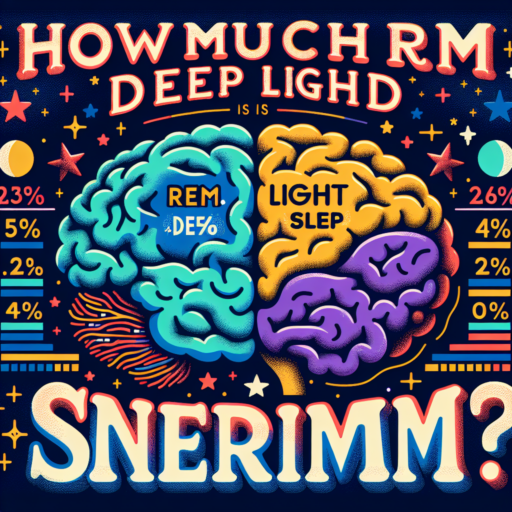How can I measure my REM sleep?
Measuring your REM sleep is crucial for understanding your sleep quality and overall health. There are several effective methods you can use to track this vital phase of sleep, each offering different insights.
Wearable Sleep Trackers
One of the most popular ways to measure REM sleep is through wearable sleep trackers. Devices such as Fitbit, Apple Watch, and various other fitness trackers offer sleep analysis features. These devices use sensors to monitor your movement and heart rate throughout the night, estimating your sleep cycles, including REM sleep. While not medically precise, they provide a useful approximation of your sleep patterns and the amount of time you spend in each sleep stage.
Smartphone Apps
Several smartphone apps are designed to measure sleep, including REM phases, without the need for wearable tech. Apps like Sleep Cycle use the phone’s microphone and accelerometer to monitor your movements and noises during sleep, calculating your sleep phases. Although convenient, these apps may not be as accurate as wearables or professional assessments due to the limitations of phone sensors.
Both of these methods can give you a ballpark figure of how much REM sleep you’re getting. However, for those looking for more precise data, a professional sleep study, known as polysomnography, can provide in-depth insights into your sleep stages. Remember, while tracking REM sleep is a step towards understanding your sleep health, it’s also important to pay attention to how you feel during the day. Consistently poor or unrefreshing sleep, even with adequate hours, warrants a discussion with a healthcare provider.
How much REM sleep should we have?
Understanding the right amount of REM (Rapid Eye Movement) sleep is crucial for maintaining overall health and well-being. REM sleep is a unique phase of sleep characterized by rapid movement of the eyes, increased brain activity, and vivid dreams. It plays a critical role in cognitive functions such as memory, learning, and emotional regulation.
Experts suggest that adults should aim for approximately 20-25% of their total sleep time to be spent in REM sleep. To put it in perspective, if you sleep for 8 hours a night, about 90-120 minutes of that should ideally be REM sleep. However, it’s important to consider individual needs as they can vary based on age, lifestyle, and overall health.
The distribution of REM sleep can also change as we age, with infants and young children spending a larger portion of their sleep in this restorative phase. This highlights the role of REM sleep in development and the differing sleep requirements at various stages of life. Moreover, disrupting the natural cycle of REM sleep, such as through sleep disorders or certain medications, can have profound effects on one’s health and daily functioning.
How do I calculate my sleep cycle?
Calculating your sleep cycle is essential for understanding how to get quality rest and wake up feeling refreshed. A typical sleep cycle lasts about 90 minutes, and each night, an average person goes through several of these cycles, transitioning through various stages of sleep. To calculate your sleep cycle, you should first aim to understand how many cycles you go through in a night and then adjust your sleep time accordingly to wake up at the end of a cycle rather than during one.
Step-by-Step Guide to Calculating Sleep Cycles
- Keep a sleep diary for a week to track when you fall asleep and when you wake up.
- Count the total hours of sleep you get each night and divide by 90 minutes (the average length of a sleep cycle) to estimate the number of cycles per night.
- Adjust your bedtime or wake-up time in 90-minute increments to ensure you’re waking up at the end of a sleep cycle.
For many, this method helps in avoiding grogginess and ensures you’re leveraging your body’s natural rhythms for optimal rest. It’s important to note, however, that individual sleep needs can vary, so listening to your body’s signals is also key.
Tools and Apps to Assist in Calculating Sleep Cycles: Nowadays, there are various apps and wearable tech designed to track your sleep stages and offer insights into your sleep cycle. Utilizing these tools can automate the process and provide a more accurate analysis of your sleeping patterns, helping you to fine-tune your sleep schedule for the best possible rest.
No se han encontrado productos.
What is a good REM cycle for sleep?
Understanding the structure of a good REM cycle for sleep is crucial for achieving restorative sleep. REM, or Rapid Eye Movement sleep, plays a vital role in our sleep architecture. During REM sleep, our brain is almost as active as when we are awake, facilitating processes critical for learning and memory. A healthy adult typically experiences REM sleep approximately 90 minutes after falling asleep, which lasts around 10 minutes for the first cycle. As the night progresses, these REM stages lengthen, with the final REM stint possibly extending up to an hour.
The cyclical nature of sleep means we go through several stages, including non-REM and REM phases. For a fulfilling rest, experiencing four to six REM cycles per night is considered beneficial. Each cycle, encompassing both non-REM and REM stages, is vital for various functions such as muscle repair, memory consolidation, and mood regulation. Hence, a «good» REM cycle involves not only the length of these phases but also seamlessly transitioning through all sleep stages.
Many factors influence the quality and duration of REM sleep, including age, lifestyle habits, and stress levels. Young adults might spend 20-25% of their sleep in REM stages, which can decrease with age. Optimizing sleep hygiene by maintaining a regular sleep schedule, creating a restful environment, and limiting exposure to screens before bedtime can enhance REM sleep quality. Additionally, avoiding caffeine and alcohol before bedtime can also improve the duration and quality of REM sleep, ensuring a refreshing and rejuvenating sleep experience.




